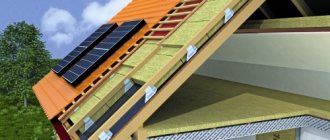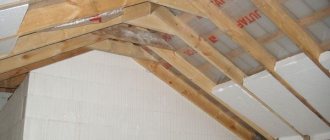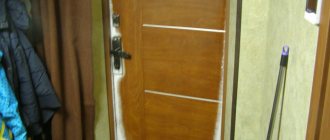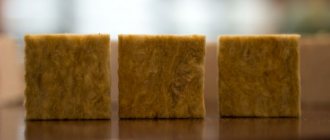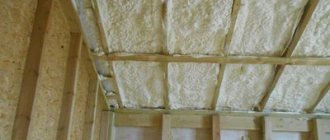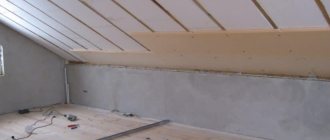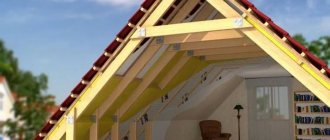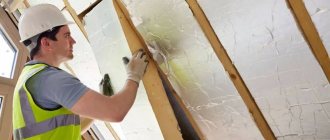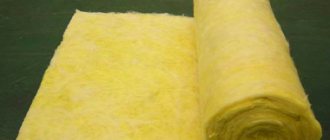In Russia, in addition to two well-known disasters, four more await us all: spring with river floods, summer with heat and fires, autumn with a bountiful harvest and winter with snow and frost. The frost is no joke. He cleans out houses and apartments. To maintain comfort and coziness in a living space, you need to heat, heat and heat. But there is another way: insulate the building on all sides and heat it.
By studying the heat loss of various buildings using a thermal imager, heating scientists compiled a map of heat losses from various structural elements of the house (shown in the figure below). It shows that the main heat loss occurs through the floor, walls, windows and roof.
There is enough work on how to insulate walls, windows and floors on the StroyGuru website. For example, the last article “Insulating walls outside with mineral wool.” But no attention was paid at all to insulating the roof from the inside with mineral wool or other types of thermal insulation materials. We will correct the omission and consider in the material below all the nuances of roof thermal insulation with glass wool and wool based on basalt fibers.
Why mineral wool
Builders with many years of experience do not think about choosing insulation for the roof. Grandfathers used glass wool, fathers added stone (basalt) wool to glass wool, and sons and grandsons continued their work. Only modern youth, when building their own home, plunge into the abyss of the Internet in search of the most effective material for roof insulation. Fortunately, there are enough theorists, including on reputable construction portals, who talk with a serious air about the use of various types of insulation for roofing.
And none of them bothered to think and then explain to novice builders why mineral wool is used in the overwhelming majority for insulation. Do not consider ecowool and polyurethane foam, and recently flax, as serious competitors on the roof. Yes, they are used, but technological difficulties with ecowool and the high cost of polyurethane foam and flax do not yet allow new products to compete on equal terms with traditional insulation.
Consequences of mistakes made when insulating the roof.
So why is roof insulation with mineral wool considered a classic? The answer lies on the surface. Before installation, the rafter system is dried to 20-25% in natural conditions, since technical drying, firstly, is very expensive, secondly, it takes several weeks, and thirdly, drying chambers still need to be found. Insulation with rigid mats, such as polystyrene foam or extruded polystyrene foam, is carried out end-to-end, and the gaps are foamed with polyurethane foam.
Rafter beams, being in ideal conditions for drying, gradually lose moisture up to 8-10%. What happens to the linear dimensions of the timber in this case? That's right, they decrease sharply, breaking away from the insulation. As a result, not bridges, but bridges of cold are formed across the entire surface of the roof. All the insulation work is going... you know where.
Mineral wool is laid flat. This means that as the thickness of the rafters decreases, the fibers will straighten, filling the resulting voids.
conclusions
So, what is the best roof insulation? You can choose the option, like most, and use mineral wool. If we are talking about insulating the floor on the roof, pay attention to ecowool . When calculated, its cost is not that high. But this is an environmentally friendly material that is not afraid of rodents. And this is a big plus. We have given enough general considerations to help you choose insulation. However, no matter how correctly the chosen material is selected, when laying the insulator it is important to adhere to the installation rules, which we described separately.
As we found out, roof insulation can be not only buns with hot chocolate, but also at least 6 other good materials. Choose and let your roof be as warm as Carlson’s.
How to choose the right mineral wool
The choice of insulation for the roof is a little specific. There are criteria here that are not present when choosing a heat insulator for other structural elements of a building. The most important among them are:
- thermal insulation properties;
- density;
- thickness;
- durability;
- noise absorption level;
- price;
- manufacturer (brand).
Attention: glass and basalt wool can be used to insulate the roof. Slag wool is not used due to its high hygroscopicity. Therefore, we will evaluate only the first two types of insulation.
Thermal insulation properties. In terms of thermal conductivity, the materials have approximately equal values. Therefore, when choosing, you can not pay attention.
Density. For a weak rafter system or a heavy roof, it is best to use glass wool with a density of 15-30 kg/m3. But here difficulties arise in attaching the insulation. It does not hold between the rafters (it cannot be fastened by surprise), it sags. This greatly complicates the insulation process. To insulate the attic, it is best to use mats with a density of about 120 kg/m3. If a flat roof is insulated from above, then grade P-175 (density 175 kg/m3) is indispensable.
The optimal density of mineral wool for roof insulation is 30-50 kg/m3 of glass wool, 55-70 kg/m3 of basalt wool.
Thickness. The thickness of the roof insulation mainly depends on the climate zone, as well as on whether the roof of the attic or attic space is insulated. There are several other small factors that heating engineers take into account, but builders completely ignore.
To calculate the thickness, there are complex thermodynamic formulas that builders with higher education cannot always master. Therefore, home craftsmen have two options: either trust many years of practice and use mats 200 mm thick, or go to the website of any well-known brand and use an online calculator (free).
When using glass wool, it is advisable to add 50 mm to the calculator values to compensate for caking.
Durability. Glass wool should be chosen only if the thermal insulation will be replaced in 15-20 years. Otherwise, it’s simply a loss of the family budget.
Soundproofing. Under the metal tiles it is necessary to lay basalt mats with a density of 75-80 kg/m3. Otherwise, you will have to live in a room with a high noise level and fall asleep to the drumming of raindrops. In addition, we should not forget that thin metal resonates well, amplifying external noise. Glass wool, even of high density, cannot cope with this task.
Price. With a limited budget for renovation work, the choice is obvious: glass wool. But if money was found for the finishing coating of a metal tile roof, then it is necessary to find financial resources for basalt wool, since glass wool is in no way suitable for this type of roof.
Conclusion: when designing, it is necessary to pre-determine the type of roof finishing, the dimensions of the timber for the rafters, the pitch of their installation and the type of mineral wool.
Manufacturer. On sale you can find both well-known brands and completely unknown manufacturers. You should opt for proven brands, which, however, does not mean that newcomers to the construction market offer low-quality products. In many cases, it’s the other way around, since the latest equipment is used for production.
The materials “TechnoNikol”, “Isover”, “KNAUF” and “URSA” are in good demand among buyers, as well as the insulation “Beltep” (Belarus), which has the best price/quality combination.
Insulation thickness
We talked more about calculating the thermal resistance of enclosing structures and what the thickness of the thermal insulation should be in a separate article. Here we can say that there are generally accepted standards that establish roof thermal resistance coefficients in different regions.
In other words, how much should the roof be able to resist heat escaping from the house. It is necessary to divide the coefficient required to obtain it by the thermal conductivity of the roofing insulating materials. Thanks to this calculation, you can find out what thickness of insulation for the roof of the house should be on the roof. A little later we will add a calculator that will allow you to calculate this important indicator.
Required materials and tools
Insulating the roof of a private house with mineral wool with your own hands will require the following materials and tools (a universal list is provided for all possible insulation options):
- basalt wool or glass wool - the specific type depends on the criteria listed above;
- vapor barrier (windproof) membrane (type A or AM);
- vapor barrier film type B (preferably C);
- tape for sealing membrane and film seams;
- polymer twine - necessary for fastening sagging fiberglass;
- wooden slats for temporary fastening of sagging glass wool;
- hammer drill - required when insulating a flat roof from the inside;
- a plastic dowel-fungus with a plastic washer-rondole (diameter 60 mm) for fastening insulation - required for fixing mats when insulating a flat roof from the inside;
- construction knife for cutting glass wool;
- a sharpened wave-shaped knife or jigsaw for cutting basalt wool;
Special knife for cutting basalt wool.
- nails or screws for wood;
- hammer for nails or screwdriver for self-tapping screws;
- stapler;
- at least 2 stepladders or ladders.
The best foam insulation
2№2. Knauf Therm House
Universal insulation that is suitable for both the facade of the house and the roof. It is made from environmentally friendly raw materials; special locks are provided for installation, eliminating the formation of cold bridges. The density of the material reaches 15 kg/m3, although it may be less. Produced in slabs measuring 1000x600 mm and 50 mm thick. Flammable
pros
- ability to withstand significant loads (up to 7000 kg per 1 sq. m.);
- use of environmentally friendly raw materials in production (no harmful emissions);
- moisture resistance.
Minuses
- fragility.
Prices for Knauf Therm House
Knauf Therm House
1№1. PSB S 15-O
In first place is lightweight polystyrene foam, which has self-extinguishing properties. This indicates the safety of the material: if a fire occurs, the insulation will extinguish on its own (it contains a fire retardant). The density is low - only 9.5 kg/m3, but the foam is easy to use and light in weight. Produced in slabs with a thickness of 60 mm and dimensions of 2000x1000 mm. Flammable
pros
- ease of installation/use;
- the presence of fire retardants, due to which self-extinguishing occurs.
Minuses
- highly flammable.
On a note! In reviews, users note that PSB S 15-O is easy to work with: the material weighs little and fits well. On average, a roof can be insulated in a day without much effort.
Prices for PSB S 15-O
PSB S 15-O
Preparatory work
The preparatory work for roof insulation has a peculiarity - it basically comes down to laying a one-sided vapor barrier membrane of type A or AM (builders call it “waterproofing”). The need for this type of work (vapor barrier) is shown in the material “Installing a vapor barrier with your own hands.”
Before laying the windproof membrane, it is necessary to ensure the integrity of the wooden roof structures (if they begin to rot, replace them), and then treat them with antiseptics and fire retardants.
In the process of fixing the membrane, several rules should be followed:
- There must be a ventilation gap between the membrane and the roofing finish. According to SNiP no less than 6 cm, in practice 4-5 cm;
- should be laid on the rafters, and not on the sheathing under the roof;
- air movement must be free over the entire surface of the roof slope. If ventilation is conditionally limited, i.e. exists for each gap between the rafters or slats (boards) separately, then in winter ice will certainly appear in certain places. This can be easily verified by those who have carried out thermal insulation work on their own;
- between the rafters the membrane should sag by about 1 cm. If pulled tightly, it can break under the influence of temperature fluctuations, like electrical wires during severe frost;
- secured with a stapler. The staples must be taped;
- laid with an overlap (15-20 cm);
- the seams are sealed with construction tape;
- If a finished roof is being insulated, the membrane can be installed using two technologies:
- with a smooth sheet at the bottom of the rafters, after which insulation is carried out in stages along a two-layer sheathing, where the first row is packed horizontally, the second, along the first, vertically;
- along the rafters, but going inside the rafter system. In this case, the insulation is laid between the rafters, using the technology of insulation from the inside without a finished roof.
Laying a windproof membrane when insulating a finished roof.
Styrofoam
It has a cheap price, and therefore is perceived by many as the best solution. But at the same time, everyone points to the shortest service life - the material decomposes, breaks.... Based on this factor alone, it already inspires serious concern in structures behind the skin, where it is difficult to check its condition.
There is also some difficulty in placing between the rafters, since the foam sheets are not as elastic as mineral wool. Precise adjustment with a float is required, leaving gaps that need to be foamed...
There has been some progress in sound insulation compared to polyurethane foam, since it is possible to cover the rafters with a layer in the counter-lattice.
But the downside is fire safety - it requires a continuous fireproof fence from the living space. Mice and birds love this material and love to breed in it. They destroy it with pleasure. Therefore, the structure must be securely closed, which is difficult to do...
Technology of roof insulation with mineral wool
There are two types of roofs: pitched and flat. Insulation of a pitched roof is carried out using two technologies:
- between the rafters;
- above the rafters. In principle, it is a gable roof. Mineral wool is used very rarely for insulation, rather as an exception. It is mainly used for insulation with rigid boards, such as extruded polystyrene foam. The method is complex and financially expensive. With a large overhang that still needs to be properly closed.
A flat roof also has two methods of insulation: from above (from the outside) and from below (from the inside), although bottom insulation contradicts all the norms and rules of building science. But it still applies, and therefore will be discussed in detail.
Insulation between rafters
The insulation algorithm between the rafters is very simple:
- mats are cut to a width 2 cm greater than the distance between the rafters;
- insulation is installed between the rafters at random;
- the insulating layer is covered with a vapor barrier film (type B or C);
- Interior finishing is mounted on top of the film if the roof slope is attic.
The technology for attaching the film completely follows the instructions for attaching the membrane.
However, there are several nuances here.
1. When laying low-density glass wool, the insulation sags. The problem is solved like this:
- every meter, a temporary strip is attached to the rafters, which holds the wool between two beams;
- in this way the span is completely insulated;
- using twine and a stapler, secure the first window between the bottom of the roof and the first batten. At the same time, the twine is constantly stretched between the rafters, rising up each time by 5-10 cm;
- The first rail is removed and work continues higher.
You can see what cotton wool fixed in this way looks like in the photo.
2. If the width of the rafters is not enough for full thermal insulation, then the first layer 10 cm thick is attached, then the sheathing is filled, and the slabs of the second layer of insulation are inserted into it. Insulation of the attic roof is carried out using the same technology. The only exception: finishing work on top of the insulating layer.
Insulation above the rafters
The technology for insulating the roof from the inside with mineral wool above the rafters consists of the following operations:
- Flooring is laid on the rafters from boards 20 mm thick. For mineral wool, it may not be continuous, but with a gap between the boards of up to 5 cm;
- a vapor barrier film of type B or C is rolled out onto the flooring overlapping from top to bottom. In some places it is grabbed with a stapler, but the main fixation will be done with the sheathing beam;
- the first row of sheathing is filled with a beam width of 10 cm (sometimes they say: height). The pitch is equal to the width of the mats, but, ATTENTION, it is 2 cm narrower so that the insulation becomes out of place;
- the first layer of insulation is laid;
- the second one is placed perpendicular to the first lathing. Here you also need a beam 10 cm high. Sometimes you can find recommendations to use a beam 12 cm wide so as not to fill the counter-lattice. It is better to abandon this idea, since the ventilation processes of the space between the windproof membrane and the roof are disrupted;
- the second layer of insulation is laid. Here it is important to avoid contact of the connecting seams with the beam of the lower sheathing;
- The thermal insulation layer is covered with a windproof membrane. How to lay it and fix it, see the “Preparatory work” section;
- a counter-lattice is placed over the membrane. For these purposes, you can use a 30x30 mm square beam or 30x40 mm slats.
Insulating a flat roof from the outside
Insulation of flat roofs from the outside is carried out on the top floors of apartment buildings, private houses, and garages. The order of work is as follows:
- Type C vapor barrier film (2) is laid on reinforced concrete floors (indicated by number 1 in the diagram);
- mats of basalt wool grade P-175 (3) are laid on the film in two layers. The slabs of each row must be installed with a shift, according to the principle of brickwork. In this case, the seams of the top row should not coincide with the joints of the bottom;
- a two-layer flat slate screed (4) is mounted on top of the insulation;
- the entire structure is filled with bitumen-polymer insulating composition (5).
By the way, it’s simple, but very expensive. However, the appearance is worth the expense, as confirmed by the photo below.
The best brands of extruded polystyrene foam
2№2. TechnoNikol XPS Technoplex
A special feature of the material is that it has a convenient edge for laying, which helps prevent the formation of cold bridges. The insulation is made from nano-sized graphite particles, due to which it has low thermal conductivity and high strength. The density reaches 30 kg/m3. Produced in 50 mm slabs measuring 1180x580 mm.
pros
- absence of formaldehyde;
- moisture resistance;
- no shrinkage during long-term use.
Minuses
- the material is flammable.
Reviews and prices for TechnoNikol XPS Technoplex
1№1. Penoplex Comfort
The peculiarity of the insulation is that it can be used in all climatic regions of the Russian Federation. It can last up to 50 years; tight joining of the slabs during installation is ensured by comfortable edges. The density of this material can be from 25 kg/m3. up to 35 kg/m3 Over the years, it does not crumble, deform or sag, completely retaining its original performance properties. Produced in slabs 1185x585 mm. Has a thickness of 5 cm.
pros
- convenient joining edge;
- long service life.
Minuses
- the material breaks easily.
